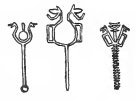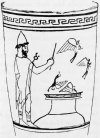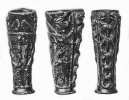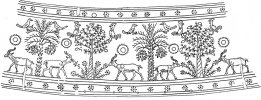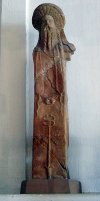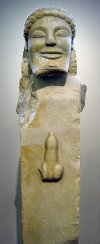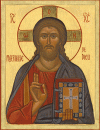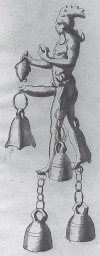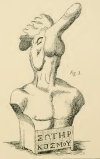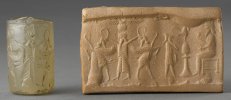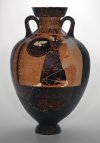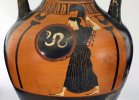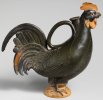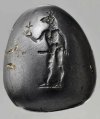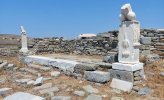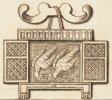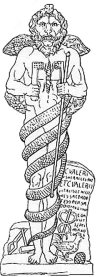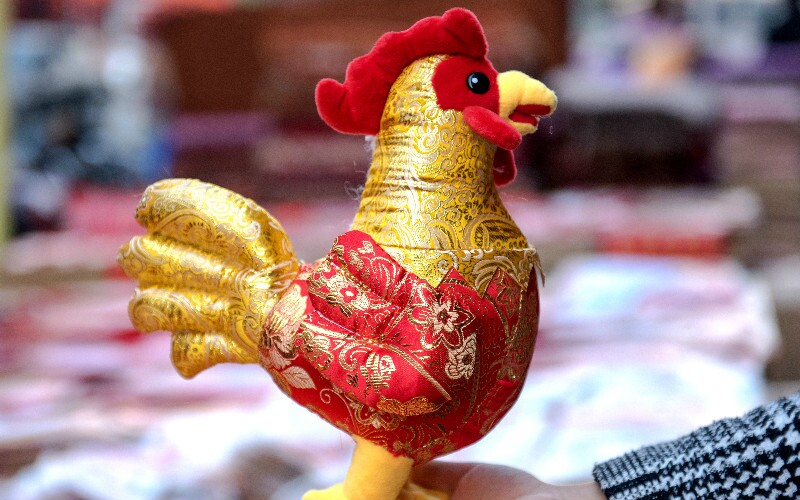Leftovers
Terminology:
Rooster- adult male bird over one year old
Cockerel- juvenile male bird of less then a year old
Capon- a male bird that has been castrated
Hen- adult female bird over one year old
Pullet- juvenile bird of less then one year old
There is no name for a spayed hen but the operation is performed mostly due to ‘egg binding’.
----------------------------------------------------------------------------------------------------------------------------------------------------------
In Zoroastrianism, the cock (Parodarsh) is “'he who foresees the coming dawn.” In 2013, a Japanese researcher, Takashi Yoshimura of Nagoya University,
published an article from his experiments with roosters and crowing. In one experiment, he took roosters and put them in complete darkness 24 hrs a day. They crowed 2 hours before the sun rose every time suggesting an internal circadian rhythm. Here’s a fun little video.
There is also something called the ‘
third watch’:
“The Jewish day began at 6:00 a.m. and finished at 6:00 p.m. The night watch began at 6:00 p.m. and ended at 6:00 a.m. The night watch was broken up into four time periods of three hours each. Mark 13:35 names the watches:
First Watch -- the evening (6:00 - 9:00 p.m.)
Second Watch -- at midnight (9:00 - midnight)
Third Watch -- at the crowing of the rooster (midnight - 3:00 a.m.)
Fourth Watch -- the morning watch (3:00 - 6:00 a.m.)”
It appears that the third watch ended at 3 am when the rooster crowed which would be well before dawn.
----------------------------------------------------------------------------------------------------------------------------------------------------------
Lampsacus may be the town where the god Priapus originated, but the current town of
Karabiga to the northeast of Lampsacus, was actually named Priapus:
“Originally a town of ancient Mysia, it was a colony of Miletus or of Cyzicus. It had a good harbour. Strabo mentions that the area produced fine wine and that the god Priapus gave the town its ancient name. Thucydides mentions the town as a naval station.”
The name Lampsacus (Λάμψακος) is also interesting because it contains the word ‘lamp’ which is ‘lámpa’ (λάμπα) which makes me think it’s in a way tied to Nusku (the ‘lamp’ deity). It was previously named Pityusa (maybe from the Avestan ‘Ušå’ meaning ‘dawn’?).
----------------------------------------------------------------------------------------------------------------------------------------------------------
I don’t know if this holds any water but I occasionally ran into Priam (Priamus/Priamos; Πρίαμος), the mythological king of Troy, and found the name Priapus/Priapos (Πρίαπος) to be very similar. From the
Priam wiki, the etymology of the name may come from the Luwians and apparently means ‘exceptionally courageous’ (cockfight?), and may also come from the Greek verb ‘priamai’ meaning ‘to buy’ (Hermes as god of merchants?).
From the
Sabazios wiki:
“Possible early conflict between Sabazios and his followers and the indigenous mother goddess of Phrygia (Cybele) may be reflected in Homer's brief reference to the youthful feats of Priam, who aided the Phrygians in their battles with Amazons.”
----------------------------------------------------------------------------------------------------------------------------------------------------------
In the introduction of the ‘
Priapeia’, Neaniskos writes about a (supposed) ritual performed by virgin women of Rome:
“According to Festus, Mutinus or Mutenus is a god differing wholly from Priapus, having a public sanctuary at Rome, where the statue was placed sitting with penis erect. Newly-mated girls were placed in his lap, before being led away to their husbands so that the deity might appear to have foretasted their virginity, this being supposed to render the bride fruitful. In Primitive Symbolism we read, 'The Romans named Mutinus or Tutenus, the isolated Phallus, and Priapus, the Phallus affixed to a Hermes.’”
“St Augustine informs us that it was considered by the Roman ladies a very proper and pious custom for young brides to seat themselves upon the monstrous member of Priapus; and Lactantius says, 'Shall I speak of that Mutinus, upon the extremity of which brides are accustomed to seat themselves in order that the god may appear to have been the first to receive the sacrifice of their modesty?’”
“It has been thought that the penis of Priapus was reddened by its exposure to the weather, and its normal condition of rigid tension. This is not so. It was painted red.”
Is it possible it was painted red to mimic the blood of a virgin? Yikes! Regardless, after I read this, for some reason a specific part in the movie “Braveheart” popped into my mind.
In the movie, the ‘old custom’ of Prima Nocta (first night) is invoked by Edward the Longshanks to breed the Scottish out. The idea of a nobleman able to claim a woman on her wedding night is actually the Latin ‘jus primae noctis’ (right of the first night). There is speculation if this actually happened but from the ‘
Droit du seigneur’ (French for ‘lord’s right’) wiki:
“In the Epic of Gilgamesh, Gilgamesh is described as having practiced a similar custom: "He is king, he does whatever he wants... takes the girl from her mother and uses her, the warrior's daughter, the young man's bride." His first meeting with his friend Enkidu is an attempt at one of these acts where Enkidu manages to stop him in a great contest of strength between the two champions.
Herodotus mentions a similar custom among the Adyrmachidae in ancient Libya: "They are also the only tribe with whom the custom obtains of bringing all women about to become brides before the king, that he may choose such as are agreeable to him.”
“When the plebeians of the Etruscan city of Volsinii rebelled against the aristocrats in 280 BC, "They took their wives for themselves and placed the daughters of the nobles under the jus primae noctis, while all their former masters on whom they could lay hands were tortured to death.”
On a side note, Mušḫuššu, “the red serpent”, a Babylonian god associated with both Marduk and his son Nabu, is a chimera that is constantly angry (
VR 3D model: see #14). There are images of gods that have their masculinity depicted as a serpent (the ancient Mesopotamian god Pazuzu (
plaque de conjuration) for instance). Priapus’s ‘endowment’ is painted red. I’m not saying there is a direct connection between Mušḫuššu and Priapus but it does stick in my mind.
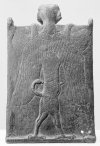
The image is of the backside of the “Conjuration Plate” showing the god Pazuzu with a snake for a phallus.
----------------------------------------------------------------------------------------------------------------------------------------------------------
A comparison between the head of a rooster and the Roman Centurion and Praetorian helmets which I think come complete with comb and wattles… and even a tail.
Helmets from
Medieval Collectibles and rooster portrait from the
chicken wiki.
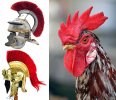
----------------------------------------------------------------------------------------------------------------------------------------------------------
The level of adoration that is exhibited by those who admire cockfighting can be on the level of the fanatic. Not all roosters will fight and so the correct and selective breeding has been done for centuries to find the best possible fighters, and the very, very best are known as Gamecocks. These are the trained and tested top-tier gladiators and I say gladiators because the parallel is practically exact. Reading from “History of Cockfighting” gives me a sense of how these birds were viewed. For instance, Scott quotes George Wilson from “The Commendation of Cocks, and Cockfighting” (1607):
“The Cocks of the game are so-called, because they carrie the credite away from all other Cocks in battell, which is the onely cause they are so highly esteemed, and so much valued as they be; for it is generally and commonly seene, that the most heroicall and noble-minded men, take greatest delight in those things which are of most courage, and greatest valour, and that of all others (in my opinion) is the Cocks of the game…”
Scott then quotes a poem but I’m unsure of the author:
“No Bird can with a well-bred Cock compare,
No Creature less then Man shall with him share;
The Honour bravely won by dint of sword,
From fiercest Foes in open field where Blood,
Flowing from dying Warriors’ fatal wounds,
Breeds richest Rubies in Bellona’s Grounds.”
Bellona was a Roman goddess of war.
He then continues:
“Although, however, the males of many breeds of poultry will, on occasion, fight grimly, determinedly and to the death if need be, with others of their kind; only in rare circumstances does one find, even among the more pugnacious breeds, a rooster that can hold his own with, much less vanquish, a representative specimen of the real Game Fowl. It is just such a bird that is so well described by Thomas Bewick, in the following passage from his famous ornithological work: “The appearance of the Gamecock, when in his full plumage, and not mutilated for the purpose of fighting, is strikingly beautiful and animated; his head, which small, is adorned with a beautiful red comb, and his chin and throat with wattles; his eyes sparkle with fire, and his whole demeanour bespeaks boldness and freedom. The feathers on his neck are long, slender, and pointed, and fall gracefully down upon his body, which is thick, muscular, and compact; his tail is long, and the flexile feathers which fall over it form a beautiful arch behind, which gives a grace to all his motions; his legs are strong, and armed with sharp spurs, with which he defends himself, and attacks his adversary; he lays hold with his beak, and strikes with the feet and wings. When surrounded by his females, his whole aspect is full of animation; he allows of no competitor, but, on the approach of a rival, rushes forward to instant combat, and either drives him from the field, or perishes in the attempt.” (Thomas Bewick, A History of British Birds, Vol. 1, Bernard Quaritch, London, 1885)
If this is the mindset seen in ancient times, then no wonder the rooster received religious status.
The rooster, however, was only one half of the equation. When breeding Gamecocks only the best females were sought after. Until 1744, the idea was that fighting-cocks played a less important role since they lose their constitution and vitality over time from constant battle whereas the hen, not being subjected to the same hazards, “was in much better condition for carrying out the process of breeding”, though Scott steers that importance away from the hen and back onto the rooster. Hens will fight. And Scott does mention that “the female of the Game Fowl often displays some of the courageous and pugnacious qualities characteristic of the male” and will even crow “to proclaim her triumph over an antagonist in typical masculine manner.” The same characteristics in a Gamecock are looked for in a Gamehen, “the strong limbs, the broad chest, the wide back, the alert eye”. Once these traits are found and bred together from whatever combination of breed (introduction of new genetic material is known as ‘outbreeding’) ‘inbreeding’, or ‘linebreeding’ often occurs, the function of which is to “fix and perpetuate the points already secured.” Breeders go so far as to breed brothers and sisters but the usual is to breed parents and children in order to keep the desired traits from becoming sullied and degraded. Scott says this is a debatable practice on the merits of successful outcomes, though he has done it satisfactorily, and says that so long as ‘outbred’ birds are of the same Game Fowl quality, outbreeding would probably give better results.
----------------------------------------------------------------------------------------------------------------------------------------------------------
It’s interesting to read some of the people who enjoyed cockfighting like Julius Caesar, Alexander the Great, Themistocles, Queen Elizabeth of England, James I and his son Prince Henry, Charles I, Charles II, Sir Walter Raleigh, the Duke of Marlborough (Winston Churchill’s ancestor) and the Duke of Essex. The oldest known cockpit was built at Whitehall Palace by Henry VIII. Anthony van Dyck (1599-1641) apparently painted a scene of a cockfight being held in Whitehall but I can’t find a copy anywhere. (there might be a much older pit I think was called ‘the legionnaires pit’ built by the Romans that I read about but didn’t bookmark and now I can’t find it)
In America, people like:
George Washington
“George Washington was reported to have been an avid devotee of cockfighting. Some accounts have Washington as maintaining a flock of Irish Greys, but it is also known that he imported a flock of Yellow Pyles or Piles from New Orleans. In a letter preserved in the archives of the Virginia Historical Society, Washington invited Thomas Jefferson to come to Mount Vernon and join him for some sport, and specifically mentioned his Yellow Pile birds. Investigators coming across the reference to Yellow Pile have allegedly misinterpreted the phrase to mean “yellow pine,” the local word for a mulatto, and from this error, it is said that some of the stories about Washington’s virtue have arisen.”
Andrew Jackson
“Andrew Jackson had been, of course, a cock raiser and gambler. One account of Jackson as a young man in North Carolina described him as “the most roaring, rollicking, game-cocking, horse-racing, card-playing, mischievous fellow that ever lived in Salisbury.” Among his papers was found a memorandum on how to feed a cock before a fight.”
“At one time cockfights were actually held in our nations capital. President Andrew Jackson kept fighting cocks in the white house stables, employing a man named Jack Freer to feed and train them. Such statesmen as Henry Clay, John C. Calhoun, Martin Van Buren, Governor John Floyd of Virginia, and many others met in the committee rooms of congress to match rooster favorites.”… “At that time cockfighting was America’s National Sport and the fighting cock lost out to the American Eagle as the Seal of the United States by only ONE vote after a bitter battle.”
Abraham Lincoln
“Abraham Lincoln, who was known to sometimes officiate in the cockfight, received the nickname of “Honest Abe” because of his reputation for fairness in refereeing cockfights. One fragmentary description of Lincoln in the cockpit does confirm the assertion that he refereed fights.
“They form a ring, and the time having arrived, Lincoln, with one hand on each hip and in a squatting position, cried, “Ready”. Into the ring they toss their fowls, Bap’s red rooster along with the rest. But no sooner had the little beauty discovered what was to be done that he dropped his tail and ran."
Benjamin Franklin attended and refereed cockfights and Thomas Jefferson was a breeder and fighter.
The original source of this info appears to come from “
Johnson’s Breeder’s and Cocker’s Guide”, third edition (1948), by William Thomas Johnson.
----------------------------------------------------------------------------------------------------------------------------------------------------------
Asclepius is the Greek god of healing, and was associated with the Roman/Etruscan god Vejovis and the c. 2700 BCE Egyptian physician
Imhotep who became deified after his death.
The Rod of Asclepius only has one snake wrapped around it and I question if Asclepius might be related to the Sumerian god
Ninazu who was the steward of the underworld (‘King of the Snakes’) and associated with healing (‘Lord Healer’). Along with his wife Ninigirida, their son was said to be Ningishzida (the Caduceus).
----------------------------------------------------------------------------------------------------------------------------------------------------------
Known as
Gastroliths and
Gizzard Stones, these stones are found in the gastrointestinal tracts of various animals that are accidentally or intentionally accumulated when swallowing food. They have even been found in dinosaurs and
moas. In the case of birds, they are intentionally eaten and stored in the gizzard in order to help grind seeds and grains for digestion. Over time they undergo a change becoming very smooth, rounded, and seemingly in many cases, transparent, some to the point of gem-like quality.
When it comes to the rooster, these stones are specifically called Alektorius (Alektor, the Greek name for rooster) and were given special reverence with claims of making the one who wears one or holds it in their mouth invulnerable. Other benefits include “eloquence, magnanimity, good character, and great charm… restore the joys of venery and make wives strive to please their husbands.” It apparently also has the ability to quench a persons thirst never having to drink again. These ideas come from the book “De lapidibus” (c. 200 CE) by Damigeron. The idea eventually developed that these stones eased gastric ailments. And the older the roosters, the better the stones. Birds had to be castrated, and live at least three years before stones could be harvested. A ten year old bird was best.
In the article “
The Capon Stone” (1973) by Thomas R. Forbes, a story from is related from 1591 where capons were being killed by the cooks and in the stomach of one of them was found “five little stones of unequal size, round and a little long, translucent like clear crystal, variegated with rather dull blueish and gold fibres or streaks, glittering with grains like opals.” It seems that one was polished and set into a gold ring by “The Very High Born Lord Christopher Gorsch” of Greiffenstein.
In Damigeron’s lapidary book “De lapidibus”, he specifically mentions the “Lapis alectorius”. A Latin translation can be found
here. He writes (Google translate):
“Alectorius stone is found in the stomachs of chickens, only in the shape of a bean, of crystal or of clear water. [2] This stone he who carries will be invincible by every man. [3] For he has already been tried and approved by many. [4] For having him as a gladiator or a warrior in his mouth, he will remain strong and free from thirst. [5] And he shall by all means conquer the athlete and the charioteer. For Milo the Croatian, carrying this stone, was never defeated. [7] Moreover, many others who had him in battle waged valiantly, and continued undefeated; and the kings, expelled from their kingdom, trusting in carrying this stone, received not only their dominion, but also another's. [8] He also makes him secure, and grateful, and pleasing to him that carry him. Moreover, in regard to venereal pleasures, he makes both strong and strong. [10] But it will also be beneficial to women who bear the things which they wish to please men. [11] For it is a common stone. [12] He also offers resolution to the ambassadors in his speech. [13] He also makes the burden beautiful, and magnanimous, and upright, and good, and who obtains all things proposed to the strong defences.”
Damigeron also takes about ‘
Heliotrope’ known as Hematite (from Greek ‘haima’ meaning ‘blood’) or Bloodstone. In its ‘classic’ form, it’s an opaque dark green jasper with red inclusions of hematite. It was called the ‘stone of Babylon’ by the German friar
Albertus Magnus (c. 1200-1280), an apparent alchemist who is said to have discovered the philosopher’s stone, and referred to the power of stones in his work ‘De mineralibus’ but does not elaborate, apparently, though Pliny the Elder (c. 1 CE) mentioned that the magicians used it as a stone of invisibility. The Gnostics apparently wore it as an amulet as did the Greeks and Romans. Ward mentions (p. 6) that the most common stone used for Egyptian cylinder seals is hematite. The most common stone used in early Babylonian cylinder seals was black serpentine (snake stone). The earliest material used for seals was shell and apparently before that, the lower joint of a reed, but these have not survived.
In an article by Ruslan I. Kostov
discussing the book “Orphic Lithica” (a c. 3 CE lapidary treatise on the magical and therapeutic properties of about 30 ‘stones’) , he mentions an interesting bit about the ‘Tears of Pine’ which corresponds to amber and was known in Ancient Greece as ‘ḗlektron’. Theophrastus (c. 371- c. 287 BCE) work “On Stones” and an Orphic poem mention amber.
The word ‘ḗlektron’ shares its meaning with another substance known in its Latinized form ‘electrum’, which is a naturally occurring alloy composed of mainly gold and silver. Coins were made out of electrum as early as c. 700- c. 600 BCE in Lydia and Eastern Greece, and c. 300 BCE, the pyramidions at the top of some Egyptian pyramids and obelisks were coated with this metal. Both ‘electrum’ and ‘amber’ come from the same root word ‘
ēléktōr’ which means ‘name of the sun’.
Also mentioned in Kostov’s article is the ‘Lychnis’ which is derived from the Greek word for ‘lamp’. In most cases it is linked to red minerals that are mostly transparent like garnets, ruby, spinel, pink tourmaline and zircon.
----------------------------------------------------------------------------------------------------------------------------------------------------------
‘Eklogḗ’ is the Greek word for ‘election’ with accompanying meanings of ‘conscious choice’ and ‘process of choosing a new leader or representative’. ‘Electo’ is the Latin word with accompanying meanings of ‘choice’ and ‘selection’. ‘Comitia’ is the Latin word for the process of choosing an individual to hold public office by the population. (
Glosbe Dictionary - All Languages of the World in One Place)
Now, a ‘Princeps Elector Imperii’ (Prince-elector, Kurfürst in German), or ‘elector’ for short, is one of the German princes of Imperial Estates (who had a higher ranking over other Imperial Princes) of the Holy Roman Empire who were entitled to elect the emperor from c. 1200 CE. I’m not saying there’s a connection with the ‘bestowing kingship’ ability from the Huma bird but I thought it was interesting since emperors, pharaohs and kings have long claimed divine lordship. (
What does the Greek term "eklektos" mean?)
----------------------------------------------------------------------------------------------------------------------------------------------------------
The Omphalos stone (at least c. 800 BCE) of Delphi, Greece seems to be similar to the Bennu stone. In the book “
Epilegomena to the Study of Greek Religion and Themis” (1927), by Jane Ellen Harrison, she basically says an omphalos stone (a holy stone of the grave of the daimon-snake) is the capstone to a ‘beehive’ or conical shaped roof that domes a subterranean tomb, but on the surface all you can see is the stone (tumulus topped with a stele). An interesting example of this might be found at the Temple of Artemis Soteira at Keramikos, Athens from at least c. 200 CE. In 2012, archeologists uncovered a well that was only discovered after the omphalos stone covering the opening had been removed. It is believed that this well was used for hydromancy (prophecy by water). Keramikos is also the site of a sizeable cemetery that was organized c. 1200 BCE and unorganized since c. 3000 BCE. (
photo)
She also mentions that a version of the tomb is a type of stone ‘money box’ in the shape of a beehive, one of which sat beside the temple of Delphi. Quoting the Roman scholar Marcus Terentius Varro (116- 27 BCE) (p. 399):
“What the Greeks call the omphalos is something at the side of the temple at Delphi, of the shape of a thesaurus, and they say it is the tumulus of Python.”
This ‘thesaurus’ (or ‘treasury’ eg: ‘Treasury/Tomb of Minyas’) or ‘money box’ sounds a bit like the ‘offering collection plates’ in church services, though in the case of the one at Delphi, the money offering is being collected in the “tumulus” of the sacred snake (Python) of Delphi just like the ‘collection box’ chained to the ‘omphalos’ in the
Church of the Holy Sepulchre. She then shows two examples of these stone, cone-shaped ‘money boxes’ one of which depicts an interesting scene engraved on the stone (p: 400):
“On the one (a) just below the hole for the money, is a shrine with Hermes holding purse and kerykeion; near him his cock.”
----------------------------------------------------------------------------------------------------------------------------------------------------------
Doing a search for what a ‘rhabdos’ was (a rod with two snakes on the end that bend to look like the number ‘8’), since it was held by Hermes, and found, along with ‘Rhabdomancy’, something called ‘
Rhabdoviridae’ which is a family of negative-strand RNA viruses in the order Mononegavirales commonly known as ‘rabies’. It derives its name from the Greek ‘rhabdos’ because of their shape, ‘a rod’. However, I noticed that it looked strikingly similar to something else that I had seen in Ward’s book on cylinder seals. I can’t say that there is a connection, but there sure is a likeness with what is called the ‘Tree of Life’ (which replaced the caduceus on Assyrian cylindar seals. (Frothingham, p.180))

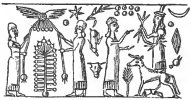
----------------------------------------------------------------------------------------------------------------------------------------------------------
I came across a
singular reference from, which states that the cock is ‘the drum of the world’. I do not understand this reference. The only thing I found, though I doubt this is what was meant, was within the action of the Ruffed Grouse (Bonasa umbellus) that only resides in North America (mostly in Canada). In beating its wings in the air (without flying), it produces a sound that has been called drumming, earning it the nickname ‘Drummer’, ‘Thunder Chicken’ (which is the best name) and ‘Carpenter Bird’. As far as I can find, it is the only bird who does this. It is also a member of the order Galliformes and family Phasiandae, the same as the chicken. Watch this video starting at 2:20 to 3:56 for a good explanation:
(
).
I’ve actually heard this sound in the mountains and it is really unmistakable.
----------------------------------------------------------------------------------------------------------------------------------------------------------
It’s quite amazing, I think, just how close our society mimics that of chicken society which we’ve named the ‘pecking order’, otherwise known as ‘
dominance hierarchy’. A perfect example of this order is found in the structure of the military and government. I must admit, to base human society on an animal society shows the mind of the one who created it. I couldn’t help but think of the state of global control after reading this portion:
“Wild and feral chickens form relatively small groups, usually including no more than 10 to 20 individuals. It has been shown that in larger groups, which is common in farming, the dominance hierarchy becomes less stable and aggression increases.”
----------------------------------------------------------------------------------------------------------------------------------------------------------
The deity Nabu became prominent among Babylonians and Assyrians in the 1st millennium BCE. He was the divine scribe who invented writing, was a god of rational arts and vegetation, was an oracle associated with the moon god Sin, and was associated with the planet Mercury. He was associated with the Greek gods Apollo and Hermes, the Roman Mercury and the Egyptian Thoth. The Akkadian word Nabu (semetic root: N-B) means “to announce, prophesize” or ‘prophet’. Nabu is Nebo in the Bible. Both Nabu and his father Marduk are depicted in Neo-Assyrian cylinder seals standing on a servant snake/dragon named Mušḫuššu (‘red snake’, ‘fierce snake’, ‘splendour serpent’), one of the offspring of Tiamat. Mušḫuššu’s other name was Sir-russu (Ward, p. 400) or Sirrush and sounds very similar to the Angel Surush from the c.1000 CE Persian poem Shahnameh, who’s equivalent is Zoroaster’s
Sraosha, the messenger (psychopomp; “the medium between man and god”) of Ahura Mazda and the embodiment of the divine word. Don't know if there is anything more than 'sounds like'.
----------------------------------------------------------------------------------------------------------------------------------------------------------
For an extensive collection of images of Dionysus see the site here (
Dionysus - My Favourite Planet People).
----------------------------------------------------------------------------------------------------------------------------------------------------------
This website on the Chinese zodiac highlights the current belief in the symbols. Although I cannot speak to the others, I found the rooster to be quite an interesting read after doing all this work because I can see where a lot of these traits might come from. A short read:
This article is an introduction on Rooster symbolic meaning in Chinese culture, and why the Rooster is loved by Chinese.

www.chinahighlights.com
----------------------------------------------------------------------------------------------------------------------------------------------------------
Justin the Gnostic (c. 2 CE) teaches about the ‘Angles of Elohim’ of which only five names have survived: Baruch, Michael, Gabriel, Amen and Esaddeus. The word ‘amen’ means ‘truth’ and is spoken after a prayer in the Christian religion. That Justin considers it an angel makes me think of all the ‘messenger gods’ who transport the prayer to whichever god the prayer or sacrifice or offering was aimed at. It’s like it’s god’s inter-office mail system that alludes the idea of ‘priority mail’. I didn’t know Amen was a ‘messenger god’ and now that I do, the whole idea of ‘messenger gods’ seems quite ridiculous to me. What’s the point?
----------------------------------------------------------------------------------------------------------------------------------------------------------
Current estimates tally the global number of domestic chickens to around 23-25 billion.
cont...



